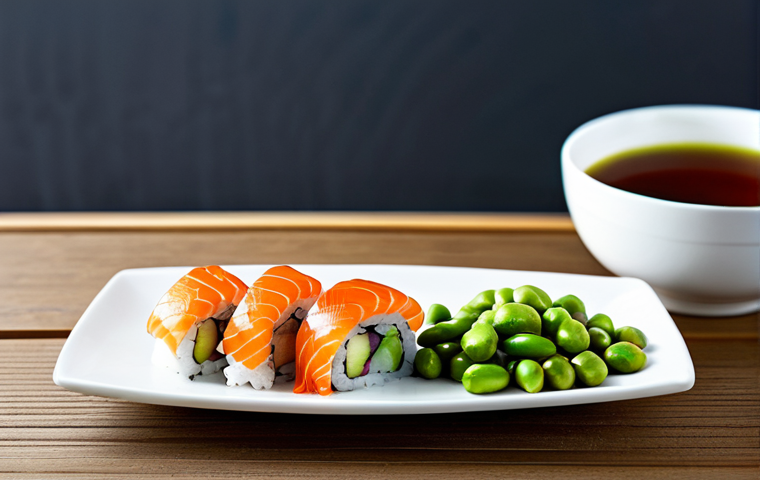Alright, let’s dive into the world of frozen sushi! For those nights when you’re craving sushi but don’t feel like going out or ordering takeout, frozen sushi can be a real lifesaver.
I’ve been experimenting with different brands, and honestly, the quality varies wildly. Some are surprisingly good, almost as fresh as what you’d get at a decent sushi spot, while others…
well, let’s just say they leave something to be desired. The convenience factor is undeniable, especially with the way things are these days – everyone is looking for a quick and easy meal option.
And with advancements in freezing technology, it’s becoming more and more difficult to tell the difference between fresh and frozen. In the future, I suspect we’ll see even *more* sophisticated flash-freezing techniques that preserve the flavor and texture of sushi even better than what’s currently available.
Let’s take a closer look in the article below!
## Navigating the Frozen Sushi Aisle: What to Look ForAlright, so you’re standing in front of the freezer section, staring down rows of frozen sushi.
Where do you even begin? First, scope out the packaging. Is it airtight?
Look for signs of ice crystals or freezer burn, which can indicate the sushi has been improperly stored or has been sitting there for a while. I once grabbed a pack that looked slightly frosty, and let me tell you, the texture was all wrong – mushy rice and dry fish.
No thanks!
Decoding the Ingredients List

Take a peek at the ingredients. Are there a bunch of unrecognizable additives? Ideally, you want to see a relatively short list of ingredients you understand.
Good quality frozen sushi will typically list the type of fish (like tuna, salmon, or shrimp), rice, seaweed, vinegar, sugar, and maybe some soy sauce or wasabi.
Avoid anything with excessive preservatives or artificial flavors. I remember grabbing one package that had a novel’s worth of ingredients – definitely not a good sign!
I always try to find options with simple, recognizable components.
Checking the “Best By” Date
This might seem obvious, but don’t skip over the “best by” or “use by” date. Just because it’s frozen doesn’t mean it lasts forever. Make sure the date is still well in the future.
I’ve made the mistake of buying something close to its expiration date, and the taste definitely suffered – the fish tasted a bit off, and the rice was stale.
It’s always better to be safe than sorry. And remember, once you thaw it, you need to eat it within a day or so!
Thawing Techniques: The Key to Frozen Sushi Success
Okay, you’ve got your frozen sushi home. Now what? The thawing process is crucial.
Don’t even think about microwaving it unless you want a rubbery, inedible mess. Trust me, I’ve been there. The best method is to thaw it slowly in the refrigerator.
The Refrigerator Method: Patience is a Virtue
Place the sushi in the fridge overnight, or for at least several hours. This allows it to thaw gradually and evenly, preserving the texture and flavor.
I usually put mine in a sealed container or wrap it tightly in plastic wrap to prevent it from drying out. I’ve found that this method yields the best results – the rice stays relatively firm, and the fish thaws nicely without becoming mushy.
The Cold Water Bath: A Faster Alternative
If you’re in a hurry, you can try thawing it in a cold water bath. Place the sealed package of sushi in a bowl of cold water and change the water every 30 minutes or so.
This can speed up the thawing process significantly. However, be careful not to let the sushi sit in the water for too long, as it can become waterlogged.
I only use this method when I’m really short on time. I have noticed it does impact the texture a bit more compared to the fridge method.
From Freezer to Plate: Serving Suggestions
Alright, your sushi is thawed. Now it’s time to get it ready to serve. Don’t just slap it on a plate straight from the package!
Presentation matters, even with frozen sushi. A little effort can go a long way in making it look and taste more appealing.
Enhancing the Presentation
Arrange the sushi on a nice plate or platter. Garnish with some fresh ginger, wasabi, and a side of soy sauce. I like to add a sprig of parsley or a few slices of cucumber for a pop of color.
I also make sure the wasabi is fresh. There’s nothing worse than dry, crumbly wasabi.
Pairing with Complementary Flavors
Consider serving your frozen sushi with other complementary dishes. A simple seaweed salad, some edamame, or a bowl of miso soup can round out the meal nicely.
I personally love having some pickled ginger on hand to cleanse my palate between bites. It really enhances the overall sushi experience.
Frozen Sushi: Addressing Common Concerns
I know what you’re thinking: “Is frozen sushi even safe to eat?” That’s a valid concern. As long as you follow proper thawing and handling procedures, frozen sushi can be perfectly safe.
Food Safety First: Storage and Handling
Make sure to store the frozen sushi in the freezer at a temperature of 0°F (-18°C) or lower. Once thawed, it should be consumed within 24 hours. Never refreeze thawed sushi, as this can compromise the quality and safety.
Also, it is recommended to always check expiration dates!
Addressing the “Freshness” Factor
While frozen sushi might not be quite as “fresh” as sushi made on the spot, it can still be a decent option, especially if it’s been flash-frozen soon after being made.
The freezing process can actually help to kill some parasites, making it safer than some fresh sushi. Ultimately, it comes down to personal preference and finding a brand you trust.
Price vs. Quality: Finding the Sweet Spot
Let’s face it, one of the big appeals of frozen sushi is the price. It’s often significantly cheaper than ordering from a restaurant. But is it worth sacrificing quality for cost?
Not necessarily. You can find some surprisingly good frozen sushi options without breaking the bank.
Comparing Price Points
Frozen sushi prices can vary widely depending on the brand, type of fish, and quantity. Do some comparison shopping to see what’s available in your area.
Don’t automatically assume that the most expensive option is the best. I’ve found some affordable brands that I actually prefer over some of the pricier ones.
I mean, quality does tend to correlate with price, but do your research.
Reading Reviews and Recommendations
Before you commit to a particular brand, check out online reviews. See what other people are saying about the taste, texture, and overall quality. Ask friends or family for recommendations.
I’ve discovered some of my favorite brands through word of mouth. If you’re able to find it, I recommend the following:
| Brand | Type of Sushi | Price Range (USD) | Overall Rating (Out of 5) |
|---|---|---|---|
| Trader Joe’s | Spicy Tuna Roll | $5-7 | 4.0 |
| Sea Cuisine | California Roll | $6-8 | 3.5 |
| Miyazaki | Assorted Nigiri | $8-10 | 4.5 |
Frozen Sushi: A Convenient Alternative?
In conclusion, frozen sushi can be a surprisingly convenient and affordable alternative to fresh sushi, especially for those nights when you’re short on time or just don’t feel like cooking.
While it might not be exactly the same as what you’d get at a high-end sushi restaurant, it can still be a tasty and satisfying meal. Just be sure to choose your brand wisely, follow proper thawing and handling procedures, and get creative with your presentation.
Enjoy! Navigating the frozen sushi aisle can be a bit of a gamble, but with the right know-how, you can snag a decent meal without breaking the bank. It’s all about knowing what to look for – from the packaging to the ingredients list – and mastering the art of thawing.
Trust me; I’ve had my fair share of frozen sushi fails, so I’m here to help you avoid the pitfalls and find the hidden gems in your local grocery store.
Decoding the Ingredients List
Take a peek at the ingredients. Are there a bunch of unrecognizable additives? Ideally, you want to see a relatively short list of ingredients you understand. Good quality frozen sushi will typically list the type of fish (like tuna, salmon, or shrimp), rice, seaweed, vinegar, sugar, and maybe some soy sauce or wasabi. Avoid anything with excessive preservatives or artificial flavors. I remember grabbing one package that had a novel’s worth of ingredients – definitely not a good sign! I always try to find options with simple, recognizable components.
Checking the “Best By” Date
This might seem obvious, but don’t skip over the “best by” or “use by” date. Just because it’s frozen doesn’t mean it lasts forever. Make sure the date is still well in the future. I’ve made the mistake of buying something close to its expiration date, and the taste definitely suffered – the fish tasted a bit off, and the rice was stale. It’s always better to be safe than sorry. And remember, once you thaw it, you need to eat it within a day or so!
Thawing Techniques: The Key to Frozen Sushi Success
Okay, you’ve got your frozen sushi home. Now what? The thawing process is crucial. Don’t even think about microwaving it unless you want a rubbery, inedible mess. Trust me, I’ve been there. The best method is to thaw it slowly in the refrigerator.
The Refrigerator Method: Patience is a Virtue
Place the sushi in the fridge overnight, or for at least several hours. This allows it to thaw gradually and evenly, preserving the texture and flavor. I usually put mine in a sealed container or wrap it tightly in plastic wrap to prevent it from drying out. I’ve found that this method yields the best results – the rice stays relatively firm, and the fish thaws nicely without becoming mushy.
The Cold Water Bath: A Faster Alternative
If you’re in a hurry, you can try thawing it in a cold water bath. Place the sealed package of sushi in a bowl of cold water and change the water every 30 minutes or so. This can speed up the thawing process significantly. However, be careful not to let the sushi sit in the water for too long, as it can become waterlogged. I only use this method when I’m really short on time. I have noticed it does impact the texture a bit more compared to the fridge method.
From Freezer to Plate: Serving Suggestions
Alright, your sushi is thawed. Now it’s time to get it ready to serve. Don’t just slap it on a plate straight from the package! Presentation matters, even with frozen sushi. A little effort can go a long way in making it look and taste more appealing.
Enhancing the Presentation
Arrange the sushi on a nice plate or platter. Garnish with some fresh ginger, wasabi, and a side of soy sauce. I like to add a sprig of parsley or a few slices of cucumber for a pop of color. I also make sure the wasabi is fresh. There’s nothing worse than dry, crumbly wasabi.
Pairing with Complementary Flavors
Consider serving your frozen sushi with other complementary dishes. A simple seaweed salad, some edamame, or a bowl of miso soup can round out the meal nicely. I personally love having some pickled ginger on hand to cleanse my palate between bites. It really enhances the overall sushi experience.
Frozen Sushi: Addressing Common Concerns
I know what you’re thinking: “Is frozen sushi even safe to eat?” That’s a valid concern. As long as you follow proper thawing and handling procedures, frozen sushi can be perfectly safe.
Food Safety First: Storage and Handling
Make sure to store the frozen sushi in the freezer at a temperature of 0°F (-18°C) or lower. Once thawed, it should be consumed within 24 hours. Never refreeze thawed sushi, as this can compromise the quality and safety. Also, it is recommended to always check expiration dates!
Addressing the “Freshness” Factor
While frozen sushi might not be quite as “fresh” as sushi made on the spot, it can still be a decent option, especially if it’s been flash-frozen soon after being made. The freezing process can actually help to kill some parasites, making it safer than some fresh sushi. Ultimately, it comes down to personal preference and finding a brand you trust.
Price vs. Quality: Finding the Sweet Spot
Let’s face it, one of the big appeals of frozen sushi is the price. It’s often significantly cheaper than ordering from a restaurant. But is it worth sacrificing quality for cost? Not necessarily. You can find some surprisingly good frozen sushi options without breaking the bank.
Comparing Price Points
Frozen sushi prices can vary widely depending on the brand, type of fish, and quantity. Do some comparison shopping to see what’s available in your area. Don’t automatically assume that the most expensive option is the best. I’ve found some affordable brands that I actually prefer over some of the pricier ones. I mean, quality does tend to correlate with price, but do your research.
Reading Reviews and Recommendations
Before you commit to a particular brand, check out online reviews. See what other people are saying about the taste, texture, and overall quality. Ask friends or family for recommendations. I’ve discovered some of my favorite brands through word of mouth. If you’re able to find it, I recommend the following:
| Brand | Type of Sushi | Price Range (USD) | Overall Rating (Out of 5) |
|---|---|---|---|
| Trader Joe’s | Spicy Tuna Roll | $5-7 | 4.0 |
| Sea Cuisine | California Roll | $6-8 | 3.5 |
| Miyazaki | Assorted Nigiri | $8-10 | 4.5 |
Frozen Sushi: A Convenient Alternative?
In conclusion, frozen sushi can be a surprisingly convenient and affordable alternative to fresh sushi, especially for those nights when you’re short on time or just don’t feel like cooking. While it might not be exactly the same as what you’d get at a high-end sushi restaurant, it can still be a tasty and satisfying meal. Just be sure to choose your brand wisely, follow proper thawing and handling procedures, and get creative with your presentation. Enjoy!
Wrapping Up
So, the next time you’re eyeing that frozen sushi, remember these tips! Don’t be afraid to experiment with different brands and flavors to find your perfect match. With a little effort and attention to detail, you can elevate your frozen sushi experience from “meh” to “amazing.” Happy sushi-ing!
Useful Information to Know
1. Always check the sell-by date and ensure the packaging is intact before purchasing.
2. For the best texture, thaw sushi slowly in the refrigerator overnight.
3. Enhance the flavor by serving with fresh ginger, wasabi, and high-quality soy sauce.
4. Consider pairing sushi with complementary dishes like edamame or seaweed salad.
5. Consume thawed sushi within 24 hours and never refreeze it.
Key Takeaways
When buying frozen sushi, always check the packaging, ingredients, and “best by” date. Thaw it slowly in the refrigerator for the best texture and flavor. Enhance your dining experience with proper presentation and complementary flavors. Remember to prioritize food safety by storing and handling the sushi correctly.
Frequently Asked Questions (FAQ) 📖
Q: Is frozen sushi safe to eat?
A: Absolutely, as long as it’s been properly stored and thawed. Most commercially sold frozen sushi undergoes a flash-freezing process that kills parasites.
Always check the packaging for safe handling instructions, and make sure to thaw it in the refrigerator, not at room temperature, to minimize bacterial growth.
I once left a package out on the counter to thaw – big mistake! Ended up tossing it because I was too worried about getting sick. Lesson learned: fridge thawing is the only way to go!
Q: How does frozen sushi compare to fresh sushi in terms of taste and texture?
A: Okay, let’s be real – it’s never going to be exactly the same as fresh sushi made right in front of you at a top-notch sushi bar. However, high-quality frozen sushi can be surprisingly good.
The key is in the ingredients and the freezing process. The best brands use fresh fish and flash-freezing technology to preserve the flavor and texture as much as possible.
You might notice a slight difference in texture, but if you add a little high-quality soy sauce and maybe some wasabi, it’s often barely noticeable. Some people swear they can tell the difference blindfolded, but honestly, I’ve served frozen sushi to guests who were none the wiser.
Q: Where can I buy good quality frozen sushi?
A: You can find frozen sushi at most major grocery stores these days. Look in the frozen food section, usually near the frozen seafood. Asian markets often have a wider selection of higher-quality options.
I’ve also had luck ordering online from specialty food retailers. Reading reviews before you buy is crucial – that’s how I’ve avoided some of the really bad stuff!
Keep an eye out for brands that emphasize sustainable fishing practices and use high-quality ingredients. A little research can go a long way in ensuring you get a decent sushi experience from the comfort of your own home.
📚 References
Wikipedia Encyclopedia


